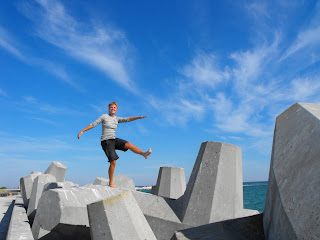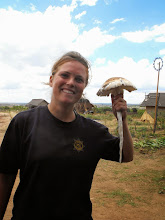I don't know how many people said its all downhill from here as of course it never was and this was never funny!! The only downhill I can prominently recall was the final 3km down to the sea, the Cape of Good Hope, the southwestern most point of the African Continent. There the road finished. I couldn't physically cycle any further. It was the end.
Cape Town seemed so far at the start but it wasn’t too far at all and I really believe anyone could do it. It is all in the mind although my mind has not come to terms with my route. I have actually cycled 13,000km; down the length of East Africa.
Having crossed the border I was experiencing some overwhleming changes... there were street lights, hand dryers and huge metal barriers steering a car all of the way around the corner. I couldn't help thinking back to the steep Blue Nile Gorge in Ethiopia which had gravel and no safety railings not to forget the decrepid remains of a bus balancing toppled over the edge a kilometre below.
In the North of South Africa the mountains rolled between rocks and shadows while my thoughts rolled still shocked going over and over ' I can't believe I've made it to South Africa.'
Between the steep shards of the mountain ranges lay farmland organised like soldiers, all suited and booted, pruned and perfected in rows so immaculately structured ready for the next season, the next war. The farm was so pristine the sheep looked like they were grazing on golf courses. There were even small reservoirs across the land to ensure a sustainable resource of water for farming.
We left the main N1 road and took the scenic route along the West Coast through to Cape Town. We cycled some more gravel roads into the depths of the countryside. Yes I can now say I am cycling fit. I realised this when I preferred cycling up the hills rather than skidding down; I was having a few problems with my brakes! Still pedaling on, the strong smell of flowers overtook my senses. I'm pretty sure it wasn't Steve although he had had his first shower in 9 days the day before and he was cycling right infront of me.
South Africa was different, more developed; I spotted the sign, that internationally well known red old man in his glasses wearing his cooking apron. There was a 5.5km KFC sign on a quiet road directing us to the built up area behind the hill.
Cycling past colourful fields fenced off by trees which were trimmed in the middle with the perfect views of the vineyards and green was all very refreshing.
Towns had western signs 'Lemon Tree Kaffee', this made me think of the streets in Ethiopia where we had to walk and ask and walk and ask for the local unmarked cafes. Not to forget that in Sudan these places were non existent. In South Africa and Namibia there are the red triangular watch out for animal signs everywhere; in North East Africa we were dodging the cows on our bikes as the animals had the right of way. The signs just got better!! The coastal route was peaceful.
As South Africa was more developed this meant I had different types of danger to be aware of, we were more careful and generally tried to camp on peoples land. This led us to some beautiful spots; my favourite was camping by the river of a nature reserve.
On my travels through South Africa I was waking up to;
• birds singing in the most dynamic rockscape
• ocean waves on the beach with the rising sun ahead
• wind swirling around natural passageways and high rising hills

I have definately accustomed myself to the noises of nature infact I have now grown to love them. In Sudan I remember lying awake worrying, hearing the tiniest creature scurrying through the sand.
In every place people talk about their neighbouring country with dangerous tales and warnings, this is definately a common theme we have found all over Africa. Again and agagin we have been treated and looked after. South Africa has even taken us to another level. We've been given:
• 10 english pounds by not 1 but 2 local people. This gets you a really good meal in South Africa which is what they both advised to get (the feed me sign on my head must have returned!!)
• 35 oranges by a delivery van that obviously didn't want to drive any further
• Water
We've also been offered numerous lifts. I can tell you now this is the WORST question to ask a cyclist. I responded in my head;
'Look at me, does it look like I need a lift. I have a fully loaded bike and I have obviously thought about this method of transport'.
This trip has definately restored my faith in humanity. I've been nowhere down the whole of East Africa where I can say I particularly felt unsafe. People are always so friendly and always want to help and add their stories and experiences to my journey. Maybe it is luck but I believe the world is much more positive than people make out.
There have been many similarities to England. The temperate climate, there is a town called Sunningdale, the BP garage (that even has the Wild Bean Cafe attached to it), the heather and plants. I could be in Chobham Common or Bracknell Forest. My thoughts were getting ready for home.
There have been some great smooth roads like Sudan (thanks again to the Chinese). I can tell the roads are good with perfectly smooth tarmac when my arse doesn't vibrate on the saddle this really makes a difference.
The hard shoulder is only used in emergency England but in South Africa the yellow line is just a marker. The space is used for slow lorries so cars can overtake etc. We ruled the hard shoulder on our bikes all the way into Cape Town. The honks of lorries were never scary screaming get out of the way like in Kenya or Tanzania they just waved exstatically to say hello. As we arrived into Cape Town we met a guy who offered us accomodation; "Would you like to stay in the city house or the beach house?". This made us giddy with excitement all the way into town.

Arriving in a flat in the middle of Cape Town and removing my bags and home for 9 months was a real comfort I felt relieved. During dinner we spoke of the stunning Cape Point route and the coast. My inital thoughts made me adament I would have a few days off. I then changed my mind very quickly and realised it was probably easier to cycle 70km a day with no luggage then get public transport!!! I thought back to the times travelling by bus where the chance of having no breakdowns were on par with winning at the fun loving slot machines. Memories also flooded back; the slowness of the whole process, the bumps on the road and the irrational speed of the drivers at the worst of times. These were not fun loving. I decided to take the easy option and cycle 140km around the Cape Peninsula to enjoy the outdoors and exercise. Without my heavy life in my panniers I felt as light as a feather and as free as a bird. My joy excelled.

We went down the West coast and enjoyed the best long winding road ever between the mountains and the ocean - the famous Chapmans Peak. This also gave us the perfect chance to stay with a great family (we exchanged details a few days back and got an invite). Our travellers luck has once again knocked us bang on the head. Thank you.
So I am currently on one big happy family holiday – well not quite but I am actually with my parents who have come out to celebrate and Steve and I squabble like brother and sister so I nearly have my whole family.
My head is flying, I can't believe I am actually flying home this month. It doesn't feel right getting on a plane after cycling the east of the African continent. Who am I kidding. YES YES YES I can't wait. If I have learned anything its that I know and really appreciate my luck
• from finding a pair of socks lying in the sand dunes when my last pair had massive holes in the toes
• to each and every person who I met that felt the need to look out for us
Steve the determined strong adventurous character faces many more challenges to come;
• Winter in Cape Town
• Another 4 years on the road
• The Patagonia mountains
• Getting across to South America in the first place
The biggest problem I have witnessed is the animals weeing on his tent. Dogs in Ethiopia, dogs in Malawi a cat in Namibia. The animal scent is permanent. This will be a problem which will continue all over the world!! Good luck to him and a massive Thank you. Without Steve this idea would never have crossed my mind. He has really been there for me and coped with my tiredness, abruptness and rudeness at the best and worst of times. Thank you for your patience, guidance and company. I would never have done anything like this without you.

I end with three rules for any cyclists
1. Never look at your speedometer or check your distance when cycling up any gradient
2. Don't attack the wind, enjoy it behind the other cyclist. Diffracted fragmented swirls of wind is much more fun and makes it slightly easier to cycle
3. Wave and smile at everything. Positive attitude gets you a long way.
So having finished the end of my trip I have cycled the Cape Peninsula, climbed Table Mountain and Signal Hill, walked every street in Cape Town and found a local pool to swim most days. I think the fitness has affected my brain, I love it. What next…
.....................................................................................................
Memories
The crowds of people screaming and waving in villages along the Nile as we cycled with sirens of our police escorts.
The friendly invites for tea from the Sudanese people into the segregated housing arrangements of the strict Muslim homes.
The kids helping pushing me up the Ethiopian mountains then running back to their cattle with an item from my pannier.
The Kenya National Parks with the most unique wildlife, lakes and beauty.
The steam evaporating in the early mornings off the tarmac roads from the rainforests of Uganda.
The swirling roads going up and down the hills of Rwanda cycling between the rice fields and tree plantations.
The flat roads of Tanzania remembered for the crazy lorry drivers, rain storms and rainbows.
The long tables covered with fish drying all over the beaches of Lake Malawi.
The markets, creative characters and tourist attractions of Zambia.
The Namibian scenery; the sunrise and sunsets in the desert dunes and on the mountains.
The best of braai and bonfires in the towns built between the mountains of South Africa.
I will never forget the streets of colourful people, local markets, parties, dancing, drumming singing and smiles. What a continent.































